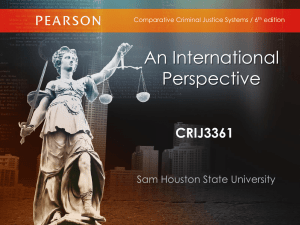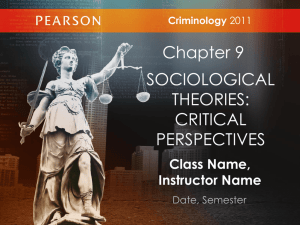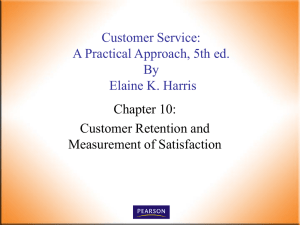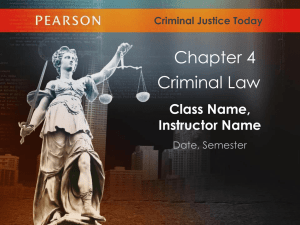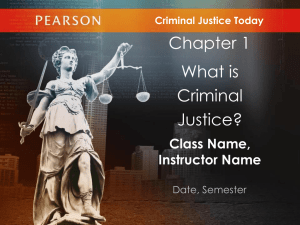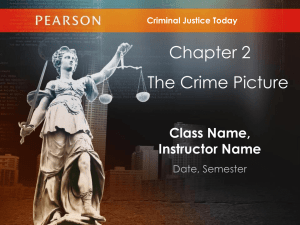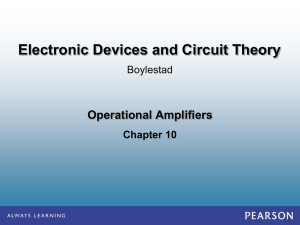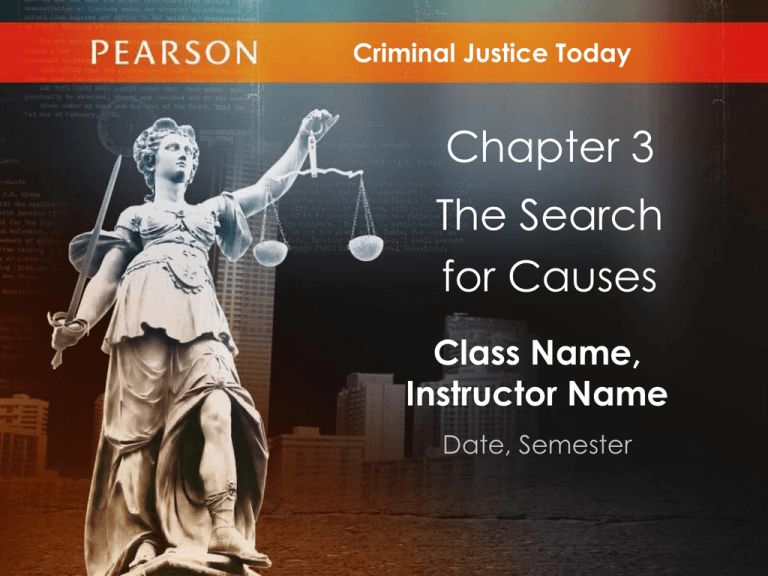
Criminal Justice Today
Chapter 3
The Search
for Causes
Class Name,
Instructor Name
Date, Semester
CHAPTER AGENDA
3.1
Summarize the development of criminological
theory, including the role of social research in that
development.
3.2
Describe the Classical School of criminology,
including how it continues to influence
criminological theorizing.
3.3
Describe the basic features of biological theories of
crime causation and their shortcomings.
3.4
Explain how the mapping of human DNA has
enhanced contemporary psychobiological
understanding of criminal behavior.
3.5
Describe the fundamental assumptions of
psychological explanations for crime and their
shortcomings.
© 2013 by Pearson Higher Education, Inc
Upper Saddle River, New Jersey 07458 • All Rights Reserved
CHAPTER AGENDA
3.6
Describe the basic features of sociological theories
of crime causation.
3.7
Describe social process theories of criminology,
including the kinds of crime-control policies
that might be based on them.
3.8
Describe conflict theories of criminality, including
the kinds of crime-control policies that might
be based on them.
3.9
Summarize three emerging theories of criminology.
© 2013 by Pearson Higher Education, Inc
Upper Saddle River, New Jersey 07458 • All Rights Reserved
Learning Objectives
After this lecture, you should be able to complete the following Learning Outcomes
3.1
Summarize the development of
criminological theory, including the
role of social research in that
development.
© 2013 by Pearson Higher Education, Inc
Upper Saddle River, New Jersey 07458 • All Rights Reserved
3.1
Introduction to Theory
Crime
5
vs.
Deviance
© 2013 by Pearson Higher Education, Inc
Upper Saddle River, New Jersey 07458 • All Rights Reserved
3.1
Most Theory Can Be Organized into four major
Categories
6
© 2013 by Pearson Higher Education, Inc
Upper Saddle River, New Jersey 07458 • All Rights Reserved
Learning Objectives
After this lecture, you should be able to complete the following Learning Outcomes
3.2
Describe the Classical School of
criminology, including how it
continues to influence criminological
theorizing.
© 2013 by Pearson Higher Education, Inc
Upper Saddle River, New Jersey 07458 • All Rights Reserved
3.2
8
© 2013 by Pearson Higher Education, Inc
Upper Saddle River, New Jersey 07458 • All Rights Reserved
3.2
9
“the greatest happiness for the greatest number”
© 2013 by Pearson Higher Education, Inc
Upper Saddle River, New Jersey 07458 • All Rights Reserved
3.2
10
© 2013 by Pearson Higher Education, Inc
Upper Saddle River, New Jersey 07458 • All Rights Reserved
Learning Objectives
After this lecture, you should be able to complete the following Learning Outcomes
3.3
Describe the basic features of
biological theories of crime causation
and their shortcomings.
© 2013 by Pearson Higher Education, Inc
Upper Saddle River, New Jersey 07458 • All Rights Reserved
3.3
12
© 2013 by Pearson Higher Education, Inc
Upper Saddle River, New Jersey 07458 • All Rights Reserved
Learning Objectives
After this lecture, you should be able to complete the following Learning Outcomes
3.4
Explain how the mapping of human
DNA has enhanced contemporary
psychobiological understanding of
criminal behavior.
© 2013 by Pearson Higher Education, Inc
Upper Saddle River, New Jersey 07458 • All Rights Reserved
3.4
14
© 2013 by Pearson Higher Education, Inc
Upper Saddle River, New Jersey 07458 • All Rights Reserved
Learning Objectives
After this lecture, you should be able to complete the following Learning Outcomes
3.5
Describe the fundamental
assumptions of psychological
explanations for crime and their
shortcomings.
© 2013 by Pearson Higher Education, Inc
Upper Saddle River, New Jersey 07458 • All Rights Reserved
3.5
16
© 2013 by Pearson Higher Education, Inc
Upper Saddle River, New Jersey 07458 • All Rights Reserved
Learning Objectives
After this lecture, you should be able to complete the following Learning Outcomes
3.6
Describe the basic features of
sociological theories of crime
causation.
© 2013 by Pearson Higher Education, Inc
Upper Saddle River, New Jersey 07458 • All Rights Reserved
3.6
18
© 2013 by Pearson Higher Education, Inc
Upper Saddle River, New Jersey 07458 • All Rights Reserved
Learning Objectives
After this lecture, you should be able to complete the following Learning Outcomes
3.7
Describe social process theories of
criminology, including the kinds of
crime-control policies that might be
based on them.
© 2013 by Pearson Higher Education, Inc
Upper Saddle River, New Jersey 07458 • All Rights Reserved
3.7
Differential
Association
Theory
20
Restraint
Theories
Labeling
Theory
Life Course
Perspective
© 2013 by Pearson Higher Education, Inc
Upper Saddle River, New Jersey 07458 • All Rights Reserved
Learning Objectives
After this lecture, you should be able to complete the following Learning Outcomes
3.8
Describe conflict theories of
criminality, including the kinds of
crime-control policies that might
be based on them.
© 2013 by Pearson Higher Education, Inc
Upper Saddle River, New Jersey 07458 • All Rights Reserved
3.8
Radical
Criminology
22
Peacemaking
Criminology
Social Policy
and Conflict
Theories
© 2013 by Pearson Higher Education, Inc
Upper Saddle River, New Jersey 07458 • All Rights Reserved
Learning Objectives
After this lecture, you should be able to complete the following Learning Outcomes
3.9
Summarize three emerging theories of
criminology.
© 2013 by Pearson Higher Education, Inc
Upper Saddle River, New Jersey 07458 • All Rights Reserved
3.9
24
New + Developing theories and causes of crime
© 2013 by Pearson Higher Education, Inc
Upper Saddle River, New Jersey 07458 • All Rights Reserved
CHAPTER SUMMARY
3.1
Summarize the development of criminological
theory, including the role of social research in that
development.
3.2
Describe the Classical School of criminology,
including how it continues to influence
criminological theorizing.
3.3
Describe the basic features of biological theories of
crime causation and their shortcomings.
3.4
Explain how the mapping of human DNA has
enhanced contemporary psychobiological
understanding of criminal behavior.
3.5
Describe the fundamental assumptions of
psychological explanations for crime and their
shortcomings.
© 2013 by Pearson Higher Education, Inc
Upper Saddle River, New Jersey 07458 • All Rights Reserved
CHAPTER SUMMARY
3.6
Describe the basic features of sociological theories
of crime causation.
3.7
Describe social process theories of criminology,
including the kinds of crime-control policies
that might be based on them.
3.8
Describe conflict theories of criminality, including
the kinds of crime-control policies that might
be based on them.
3.9
Summarize three emerging theories of criminology.
© 2013 by Pearson Higher Education, Inc
Upper Saddle River, New Jersey 07458 • All Rights Reserved

